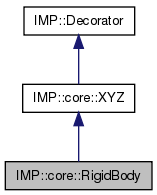A rigid body particle describes a set of particles, known as the members, which move rigidly together. Since the members are simply a set of particles which move together they don't (necessarily) define a shape. For example, the members of the rigid body made from a molecular hierarchy would include particles corresponding to intermediate levels of the hierarchy. As a result, methods that use rigid bodies also take a Refiner to map from the rigid body to the set of particles defining the geometry of interest.
The initial orientation of the rigid body is computed from the coordinates, masses and radii of the particles passed to the constructor, based on diagonalizing the inertial tensor (which is not stored, currently).
A rigid body stores the a set of local coordinates for each member and an algebra::Transformation3D mapping between the local coordinates and the actual location of the member.
It is often desirable to randomize the orientation of a rigid body:
# Assume p is a RigidBody Particle
rbd= IMP.core.RigidBody(p)
translation=IMP.algebra.get_random_vector_in(IMP.algebra.Vector3D(0,0,0),
10.0)
# we don't yet have python code to generate a nearby rotation
rotation= IMP.algebra.random_rotation()
transformation= IMP.algebra.Transformation3D(rotation, translation)
# note, this overwrites the existing position
# The True is to transform the members now rather than wait for a
# score state
rbd.set_transformation(transformation, True)
# to instead perturb the existing transformation instead do
rbd.set_transformation(IMP.algebra.compose(rbd.get_transformation(),
transformation))

Public Member Functions | |
| void | add_member (RigidBody o) |
| Add another rigid body. | |
| void | add_member (XYZ d) |
| Add a particle as a member. | |
| algebra::VectorD< 3 > | get_coordinates () const |
| Get the coordinates of the particle. | |
| bool | get_coordinates_are_optimized () const |
| RigidMember | get_member (unsigned int i) const |
| RigidMembers | get_members () const |
| unsigned int | get_number_of_members () const |
| algebra::VectorD< 4 > | get_rotational_derivatives () const |
| Get the derivatives of the quaternion. | |
| IMP::algebra::Transformation3D | get_transformation () const |
| Get the transformation implied by the rigid body. | |
| void | lazy_set_transformation (const IMP::algebra::Transformation3D &tr) |
| Change the transformation, delay updating the members until evaluate. | |
| void | normalize_rotation () |
| Normalized the quaternion. | |
| RigidBody (::IMP::Particle *p) | |
| void | set_coordinates_are_optimized (bool tf) |
| Set whether the rigid body coordinates are optimized. | |
| void | set_transformation (const IMP::algebra::Transformation3D &tr) |
| Set the current orientation and translation. | |
| void | update_members () |
| Update the coordinates of the members. | |
Static Public Member Functions | |
| static RigidBody | decorate_particle (::IMP::Particle *p) |
| static bool | particle_is_instance (Particle *p) |
| Return true of the particle is a rigid body. | |
| static RigidBody | setup_particle (Particle *p, const RigidMembers &members) |
| Create a rigid body based on members of another one. | |
| static RigidBody | setup_particle (Particle *p, const XYZs &members) |
| Create a new rigid body from a set of particles. | |
Related Functions | |
| (Note that these are not member functions.) | |
| IMP::core::RigidBody | setup_as_rigid_body (Hierarchy h) |
| Rigidify a molecule or collection of molecules. | |
| void | transform (RigidBody a, const algebra::Transformation3D &tr) |
| Transform a rigid body. | |
| void IMP::core::RigidBody::add_member | ( | RigidBody | o | ) |
Add another rigid body.
Rigid bodies can be tied together so that one updates the other.
| void IMP::core::RigidBody::lazy_set_transformation | ( | const IMP::algebra::Transformation3D & | tr | ) |
Change the transformation, delay updating the members until evaluate.
| void IMP::core::RigidBody::set_transformation | ( | const IMP::algebra::Transformation3D & | tr | ) |
Set the current orientation and translation.
All members of the rigid body will have their coordinates updated immediately.
| static RigidBody IMP::core::RigidBody::setup_particle | ( | Particle * | p, | |
| const RigidMembers & | members | |||
| ) | [static] |
Create a rigid body based on members of another one.
This function creates a rigid body that is part of another one. The member particles passed must be part of the same rigid body and the created rigid body is added to that one as a member. The purpose of this method is to, for example, define a rigid body for part of a large molecule that is also rigid.
The passed members do not become members of this rigid body, as there would be no point.
| static RigidBody IMP::core::RigidBody::setup_particle | ( | Particle * | p, | |
| const XYZs & | members | |||
| ) | [static] |
Create a new rigid body from a set of particles.
| [in] | p | The particle to make into a rigid body |
| [in] | members | The particles to use as members of the rigid body |
| IMP::core::RigidBody setup_as_rigid_body | ( | Hierarchy | h | ) | [related] |
Rigidify a molecule or collection of molecules.
The rigid body created has all the leaves as members and a member rigid body for each internal node in the tree.
| void transform | ( | RigidBody | a, | |
| const algebra::Transformation3D & | tr | |||
| ) | [related] |
Transform a rigid body.
The transformation is applied current conformation of the rigid body, as opposed to replacing the current conformation, as in RigidBody::set_transformation().